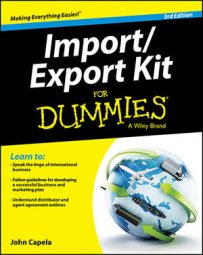You've chosen your supplier and you're ready to buy products for your import business. To make sure that the transaction goes smoothly, you need to come up with a contract that spells out all the pertinent information.
Many potential sources of confusion exist between an importer and an overseas supplier, from language difficulties to differences in business practices. That's why a clear written contract is so important. If disagreements do arise, you'll have an easier time resolving them if you have a written contract than you would if you relied solely on an oral agreement.
Your contract should make all aspects of the trading process — what will happen, when it will happen, and exactly what each party is responsible for at each stage — as clear as possible. Here are the key points of agreement between an overseas supplier and a U.S. importer:
The products: Specify which goods you're buying, noting the exact specifications with which the products must comply.
Sales targets: This includes how much you're ordering and the frequency of shipments.
Territory: Spell out the territory in which the distributor (importer) may sell and whether the distributor (importer) will have exclusivity there.
Price: How much will you pay? In which currency? At which exchange rate?
Payment terms: Specify when and how payments will be made. Will the terms be letter of credit, sight draft, open account, 30 days, or consignment?
Shipping terms: Specify exactly who is responsible for shipping costs, duties, and Customs-related formalities. Use internationally accepted Incoterms (international commercial terms), such as FOB, FAS, C&F, and CIF, so you're on the same page as the supplier.
Level of effort required of the importer: How hard must you work to sell the products? This entails a minimum order commitment and long-term order commitments. Basically, the supplier wants to make sure you're not going to place one order and then bail on his product if it doesn't work out.
Delivery: How will the goods be transported to you?
Insurance: Be clear about who bears what risks (for example, loss or damage) at each stage of the process.
Sales promotion and advertising: Who will do it? Who will pay for it? How much will be invested in it?
Warranties and service: How will you handle defective or unsold products?
Order lead time: Include the procedures that would be implemented if a dispute were to arise — for example, if one party's error causes delays or losses for the other.
Trademarks, copyrights, and patents: If applicable, who will register, and in whose name will the trademark, copyright, or patent be?
Provision for settlement of disputes: If there is a dispute, where will legal proceedings be heard?
Provision for termination of the agreement: If you negotiated an agreement for a particular territory and you aren't happy with the product and want to discontinue that relationship and find a new supplier, you need to know how to get out of the agreement.
The contracts you have with a supplier will evolve as your trading relationship evolves. Early contracts may be on a shipment-by-shipment basis, but longer-term contracts may follow as familiarity and trust develop between the parties.

